Every educator, from kindergarten to graduate school, should contribute to the important and significant work of teaching students to use online sources and social networks for educational and professional goals. To ignore the technology, or assume that our students already know it because they use it every day, is to participate in educational malpractice.
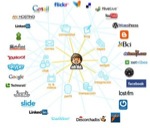
I teach Freshman Composition and Freshman Literature at an urban open-entry state institution. My students’ primary use of the internet is on smartphones and tablets. Few of them have internet at home, and most of them cannot afford a computer.
In order to assist my students in transitioning their use of the internet from primarily social and entertainment use to academic use, I have made it a priority in my classes for at least five years now. Most students are relieved when I inform them that they’re not only allowed to use their devices in my classroom, but they are encouraged to use them. (This requires a clear policy for use included in the syllabus.)
I have found that the best way to lasso the educational potential of the internet is to teach my students how to use it in practical ways on a daily basis. I like to start the semester with a short lecture about study tools they can use in all their classes (Quizlet, Studyblue, Evernote, Google Docs), and then slowly build up their knowledge by adapting a THATCamp activity called a “Dork Short” (a 2-minute mini-lecture) about a single specific tool that I or one of my extra-credit seeking students offer at the start of class each day. Not only does this activity increase their knowledge about what is out there, but it also builds a need in my students to learn about digital curation. They want to know how to store this information because it’s valuable to them. I have found that building a hunger in my students for a specific digital skill increases their attention span, retention, and use of the internet for educational purposes (i.e. “Do you want to keep that great website you just heard about? Great! Here’s a free tool called Evernote. You want to start to build a digital library of sources so you can use them in your papers? Wonderful! Let’s learn about Zotero!”)
As we move through the semester, I start using some of the tools in class, and as the students complete assignments, they start to learn about building networks, using blogging platforms for the creation of digital writing projects with interactive media, and sharing their work. So, how do I do this? I’m afraid the onus is on me. I have to learn the technology well enough to demonstrate it to my students.
The integration of constantly changing educational technology requires a commitment from me to be a learner as well as a teacher, and it has forced me to move outside my comfort zone to try tools I’m unfamiliar with. But I’m not alone in this unfamiliar terrain. Someone who is absolutely new to using educational technology can become just as proficient as someone who has been doing this for ten years, because the tools are new: no one is an expert! I didn’t start out being a techie. Five years ago, I didn’t even own a smartphone, but I took a job in a program that required me to use technology to teach writing, and I learned the biggest lesson technology had to offer: we are all learners.
I have learned to embrace the uncertainty of new technology and use it to involve my students. When I bring up a new tool, I tell my students it is new to me. I show them what I know, share how I think it’s valuable, and ask them how they might use it. I ask them if they use it already, and when I make a mistake, I ask them for suggestions. We have to change our own personal reaction to technology, and we have to embrace new ways to teach using these tools.
The hardest thing about using new tools is knowing where to find them and why they might be useful. This brings up the importance of Professional Learning Networks (PLNs). You may not realize it, but you already have a personal learning network. You might have some buddies from college that you bounce ideas off, or turn to when you are stuck. If you are an educator, there are members of your department or school that you share ideas with. Right now, that is your PLN. But if you want to know about something beyond your current PLN, you will need to include yourself in a larger social group and expand your PLN. There are a couple ways to do this, but one of the most effective ways I’ve found is to start using social networking.
These are some of the tools I use to connect with other educators to learn about what is new in teaching writing, in technology, and in education in general:
Twitter
When I ask my colleagues if they use Twitter, most of them give me a scowling expression and state, “I don’t have time for that.” They seem to be of the mind that Twitter is a distraction from their professional responsibilities, something that they would do if they want to follow a celebrity or become a social media butterfly, but for them it isn’t a serious tool. This is an impression I fight hard to change. Twitter is not Facebook in 140 characters, it is something entirely different. I use Twitter almost exclusively as a professional communication tool.
Even if you are already using Twitter as a personal social network, I highly recommend establishing a professional Twitter account for use as a PLN. When you establish your account, try using a variation of your name so others can find and identify you easily (I’m @drkassorla), and put up a short biography that says where you work and what you tweet about. But it isn’t as easy as just throwing up a Twitter ID and tweeting your thoughts to the world; there is a strategy to using Twitter effectively for professional networking.
When I tweet, I try to include three things in each tweet: a short statement, a link, and a hashtag. For example, let’s say you found a great online journal you wanted to share. Your tweet might look like this:
 The comment, of course, is a quick summary of what your link contains. The link is a shortened version of an internet URL. It isn’t necessary to shorten any link you put into a tweet, as Twitter will automatically shorten it for you. This saves you time and effort, and most importantly, it saves characters. Each tweet can only be 140 characters, so every word counts. Also, if you want your tweet to be shared by others, you need to leave at least 20 characters free so that subsequent retweets are not cut off. (Twitter automatically counts your characters and spaces, so you don’t have to.)
The comment, of course, is a quick summary of what your link contains. The link is a shortened version of an internet URL. It isn’t necessary to shorten any link you put into a tweet, as Twitter will automatically shorten it for you. This saves you time and effort, and most importantly, it saves characters. Each tweet can only be 140 characters, so every word counts. Also, if you want your tweet to be shared by others, you need to leave at least 20 characters free so that subsequent retweets are not cut off. (Twitter automatically counts your characters and spaces, so you don’t have to.)
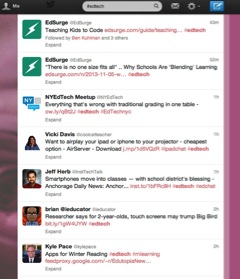
A hashtag might be new to you if you haven’t been using Twitter, but it is a simple concept. A hashtag is a way of sharing and organizing content across Twitter accounts. So, if I want to find out information about educational technology, for example, I might put “#digped” into the Twitter search box. This will allow me to see everything that anyone on Twitter is sharing about digital pedagogy. Hashtags are not permanent, and anyone can use a hashtag for any reason, but there are some that are well-used and will constantly connect you with a specific audience.
A hashtag is made of two elements — a hash mark (#), and a tag (a descriptive label). You can put whatever you want after a hash mark to make a hashtag, but there are some established hashtags for education. The most popular hashtags, according to “The A-Z List of Educational Hashtags,” written by Kati Lepi for Edudemic, are:
- #edchat — Education, worldwide (lots of US teachers). A really useful hashtag if you are interested in tweeting with a wide range of educators worldwide.
- #schools — Massively wide ranging but used far less than #edchat or #ukedchat
- #teaching — This hashtag seems to largely be used for jobseeking, FYI
- #lrnchat — Learning chat
- #TT — Teacher Tuesday where educators suggest others to follow
- #kinderchat — hashtag for discussing kindergarten aged children
- #EdChatIE — The educational hashtag for Ireland for all three levels
- #ukedchat — UK Education
- #ClavEd — The educational hashtag for French Speakers — Wednesdays at 12h(EST) 18h(Paris)
- #GlobalEd — Education with a global dimension
OK, so now you know how to post something to a list of other educators, but how do you find that list so that you can learn? That part’s easy! Just go to your twitter homepage and enter “#edchat” or “#edtech” into the search box. You will then see the other educators who are participating or posting to those hashtags. Why is this important? Because, if you can find the educators who are participating in hashtagged conversations, you can then begin clicking on their Twitter IDs and following them. Usually, they will follow you back. Now, you are beginning to develop your Twitter PLN! Next, establish a habit of tweeting or retweeting at least three new items each day. This will keep you in contact with your new Twitter colleagues and keep you learning and sharing.
In addition to simple posts, a lot of educators take part in organized hashtag conversations that take place at a particular time on the web and are often mediated by one or more people and/or focus on a particular question. These conversations can be easily found and followed by putting the hashtag for the conversation into the search box in Twitter, and then participating by including the hashtag in your comments. As you can see from the list above, one of the most popular hashtags #claved, is used at a specific time to connect French Speaking educators into a live global conversation. There is a convenient and updated list of regular Twitter Chats curated by @thomascmurray, @cevans5095, and @cybraryman1 organized by day and time.
Diigo
If Twitter still isn’t your cup of tea, you might check out Diigo. Diigo is one of several social bookmarking sites on the internet, where participants can share items of interest with specific groups. There is an excellent “Diigo in Education” group that I recommend for anyone who wants to participate in a great PLN. In order to participate, you will need to establish an educational Diigo account, which usually requires an e-mail address ending in “.edu.”
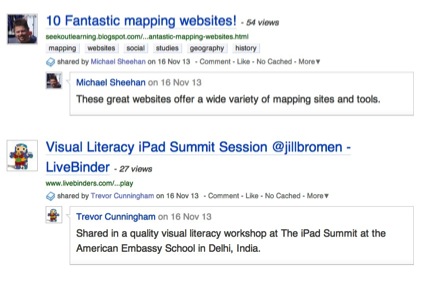 On Diigo, you can share URLs and a short summary of the tool or resource. It’s not only a good PLN, but I have also found that it is a good way to involve students in understanding the use of PLNs. It moves a bit slower than Twitter, so they have more time to take in the information and even participate in the social bookmarking there. Another way that I have used Diigo is to create a Diigo group of my own, and encourage students to post technology resources they want to share with other students in my class.
On Diigo, you can share URLs and a short summary of the tool or resource. It’s not only a good PLN, but I have also found that it is a good way to involve students in understanding the use of PLNs. It moves a bit slower than Twitter, so they have more time to take in the information and even participate in the social bookmarking there. Another way that I have used Diigo is to create a Diigo group of my own, and encourage students to post technology resources they want to share with other students in my class.
Pinterest
Pinterest is one of the newest, and one of the most successful social networking sites today. It allows you to “pin” anything you find on the web to a virtual bulletin board where others can access that information. It has become an excellent site for sharing educational information, with teachers establishing boards as broad as “Teaching,” and as specific as “Challenge-Based Learning.” If you join Pinterest (for free), you can establish your own boards, then start pinning ideas you want to curate and repinning ideas from others onto your boards. This is an easy, friendly, almost un-techy way of participating in a PLN — but there is very little personal interaction. Most of what goes on in Pinterest is pinning and repinning information.
A note of caution with Pinterest: the boards are visual, and can link to anything. Before repinning an item on Pinterest, you must make sure that the link does not go to inappropriate or commercial sources that have little to do with your interests. Sometimes, images don’t link to anything. Check every link before pinning to make sure the links are active and appropriate.
These are the 25 most popular Pinterest Boards in EdTech. You will find my boards at http://www.pinterest.com/mkassorla.
Wrapping it up: Using and Curating a PLN in a PLE
Curation — the ability to hold on to some of the information that we gather on the Internet — is important. We may not use every tool right now, but we may want to down the line, or maybe a student comes to us and asks if we have a tool they can use for a specific purpose — like creating a stop-motion film or presenting a video mashup. Some of the PLN tools I’ve discussed have curation already built in (like Pinterest), but others move so quickly (like Twitter) that you may have difficulty holding on to so much information without some organizational assistance.
There are two techniques I use to curate the information I gain from my internet PLNs which may be of use to others in keeping track of digital resources. The easiest is to take resources from PLNs like Twitter and repost them into Pinterest or Diigo (or both). In fact, most of the information I share on Twitter is a repost from information I gathered on Pinterest or Diigo, and most of the information I post to Pinterest is a repost from the information I gathered on Twitter or Diigo. I have learned that most people do not utilize multiple PLN resources like I do, so I’ve found that reposting this information not only strengthens my memory of the information, but it also strengthens my position within the PLN. I’m not only learning from others, I’m also sharing something they don’t know.
In addition, I often share information with students and colleagues for a specific purpose. In those cases, I often use a dashboard system to organize the information easily, and to create what is known as a “Personal Learning Environment” (PLE).
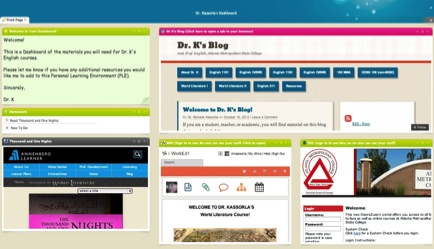 A Dashboard is one central place you can go to find everything you need. There are some very good free dashboard systems on the web that you can make into the homepage on your browser.
A Dashboard is one central place you can go to find everything you need. There are some very good free dashboard systems on the web that you can make into the homepage on your browser.
- Netvibes: I use Netvibes to establish my student’s PLE. Netvibes allows you to use widgets to attach websites, apps, twitter feeds, and RSS feeds to one dashboard so that everything is in one place. This is an example of my published dashboard that I use for my students’ PLE: http://www.netvibes.com/drkassorla
- Symbaloo: Another popular dashboarding system is Symabloo. Symbaloo allows you to enter icons into a grid so that you can easily access the websites you use most often. You can create private and public Symbaloo sites for your private PLN and your students’ public PLE.
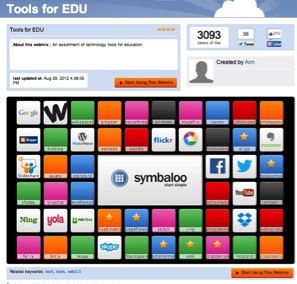
One of the best things about using dashboards is that they are easily customized — they put everything at my fingertips. I can put a dashboard up on my Smartboard and use the links in that dashboard to get to all the resources I need for the class — not only making my class presentations more efficient, but modeling the efficient use and curation of technology in my own classroom.
The most important thing I can do is let my students see my excitement and curiosity about new technology, how I learn about it, how I play with it, and how I think about integrating it into my own work on a daily basis. Often, I will pull up a new tool I just learned about and show my students how it works. I fumble a lot. I make a lot of mistakes, and I laugh at myself. I ask for assistance from my students, and I ask them how they think I could use the tool in future classes. They like being the experts, and they enjoy sharing their opinions with me and the rest of the class.
I admit that my use of new technology is almost never smooth, but it is authentic. This open and authentic view of how we all learn about new tools is one of the best ways I’ve found to insure that my students have a healthy attitude toward using new tools in their own learning. I want them to see that finding, using, and curating technology for their own use isn’t something scary or formal. Educational uses of the technology may be new to my students, but it comes to them swiftly when they start to get an idea of how it is done. Hopefully, my students will carry this knowledge through to their other professors, to their professional contacts, and to their own children. It’s a small step, but it’s an important one to take if we are to begin to change the culture around educational technology.

